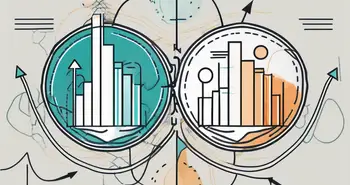What Does Liquidation Mean in Trading? A Comprehensive Guide to Understanding Market Risks

Trading in financial markets can be an exhilarating experience, but it comes with a fair share of risks. One such risk that traders need to be aware of is liquidation. In this comprehensive guide, we will explore what liquidation means in trading and how it can impact market participants. By understanding the concept of liquidation and its implications, you will be better equipped to navigate the complex world of trading and make more informed decisions. So, let's dive in!
Understanding the Basics of Trading
Before we delve into the specifics of liquidation, it's important to grasp the fundamentals of trading. Trading, in its essence, involves buying and selling financial assets in various markets, such as stocks, commodities, or cryptocurrencies. Traders take advantage of price fluctuations to generate profits. However, this potential reward comes with inherent risks, including the possibility of losing money.
The Concept of Liquidation in Trading
Liquidation is a process that occurs when a trader's account balance falls below a certain threshold, triggering the automatic closure of their positions. Put simply, it's the point where losses reach a level that the trader's account can no longer sustain, leading to the forced exit of trades. It is important to note that liquidation can occur in both long and short positions.
Liquidation is primarily driven by the use of leverage. Leverage allows traders to control larger positions in the market with a smaller amount of capital. While this can amplify profits, it also magnifies potential losses. If the market moves against a leveraged position, losses can accumulate rapidly, eventually leading to liquidation.
Key Terms in Trading You Should Know
Before we proceed, let's familiarize ourselves with some key terms commonly used in trading:
- Margin: The collateral required by a broker to execute trades.
- Leverage: The ability to control a larger position in the market with a smaller amount of capital.
- Stop Loss: A predetermined price level at which a trader's position will automatically be closed to limit potential losses.
- Market Order: A type of order where the trade is executed at the best available price in the market.
- Liquidation Price: The price at which a trader's positions will be automatically closed if losses exceed a certain threshold.
The Process of Liquidation in Trading
Now that we understand the concept of liquidation, let's explore how it occurs in different market conditions and the role of brokers in this process.
How Liquidation Occurs in Different Market Conditions
Liquidation can happen in various market conditions, but it is more common during periods of high volatility or sudden price movements. When prices rapidly fluctuate against a trader's position, it can deplete their account balance, pushing it below the required margin level and triggering liquidation.
It is essential for traders to monitor market conditions closely and adjust their risk management strategies accordingly to mitigate the potential impact of liquidation.
The Role of Brokers in Liquidation
Brokers play a crucial role in the liquidation process. They are responsible for monitoring traders' accounts and ensuring that margin requirements are met. When an account approaches the liquidation threshold, brokers will automatically close out the trader's positions to protect both parties involved.
Choosing a reliable and reputable broker is paramount, as their expertise, infrastructure, and risk management protocols can significantly impact the frequency and severity of liquidation events.
The Impact of Liquidation on Traders
Liquidation not only has financial implications but can also take a toll on traders' emotional and psychological well-being. Let's explore both aspects:
Financial Implications of Liquidation
Liquidation can result in substantial financial losses for traders. When positions are forcibly closed, any further price movements in favor of the trader's initial position go unrealized. It is crucial for traders to manage their risk effectively and employ appropriate risk management tools, such as setting stop-loss orders, to limit potential losses.
Emotional and Psychological Effects of Liquidation
Experiencing liquidation can be emotionally challenging for traders. It can lead to feelings of frustration, disappointment, or even self-doubt. It's important to remember that losses are an inherent part of trading and can happen to even the most experienced traders.
As an expert in trading, I would like to share a personal story. Early in my trading career, I faced a significant liquidation event due to an unexpected market reversal. It was a tough experience, but it taught me the importance of risk management and staying resilient. I learned to embrace losses as valuable learning opportunities and to never allow emotions to cloud my judgment.
Strategies to Mitigate Liquidation Risks
While liquidation risks are an unavoidable aspect of trading, there are several strategies you can employ to minimize their impact:
Effective Risk Management Techniques
Risk management should be at the core of every trader's strategy. Setting appropriate stop-loss orders, diversifying your portfolio, and avoiding excessive leverage are some of the key techniques to mitigate liquidation risks. By setting disciplined risk parameters and sticking to them, you can protect your capital and reduce the likelihood of liquidation.
Importance of Diversification in Trading
Diversifying your trading portfolio is another effective way to reduce the impact of liquidation risks. By spreading your investments across different asset classes or market sectors, you minimize the potential losses resulting from a single adverse market event. Diversification can help cushion the impact of liquidation and provide a more balanced long-term trading strategy.
The Future of Trading and Liquidation
As technology continues to reshape the financial landscape, it also has a significant impact on the liquidation process. Let's explore the future of trading and how advancements in technology are influencing liquidation risks.
Technological Advancements and Their Impact on Liquidation
With the rise of algorithmic trading and automated systems, the speed and efficiency of the liquidation process have improved significantly. Brokers now have access to advanced risk management tools and real-time monitoring systems, enabling them to respond swiftly to rapidly changing market conditions. This technological progress has contributed to reducing the frequency and severity of liquidation events.
Predicting Market Trends and Liquidation Risks
The ability to predict market trends and anticipate potential liquidation risks is a crucial skill for traders. As technology evolves, sophisticated data analysis techniques, such as machine learning and artificial intelligence, are becoming more prevalent in the trading world. These advanced tools can help traders identify patterns, analyze market sentiment, and make more informed decisions to mitigate liquidation risks.
FAQ
What is liquidation in trading?
Liquidation in trading refers to the process of closing out a trader's positions when their account balance falls below a certain threshold, typically due to excessive losses. It is triggered by the inability to meet margin requirements.
How does liquidation occur?
Liquidation can occur when the market moves against a trader's position, causing losses that deplete their account balance to a level where it can no longer sustain open positions. Brokers play a critical role in monitoring accounts and automatically closing positions when liquidation becomes imminent.
What are some strategies to mitigate liquidation risks?
Effective risk management techniques, such as setting appropriate stop-loss orders, diversifying your portfolio, and avoiding excessive leverage, can help mitigate liquidation risks. Additionally, staying informed about market trends and utilizing advanced trading tools can aid in identifying potential risks before they escalate.
Is liquidation purely a financial concern?
No, liquidation can also have emotional and psychological effects on traders. Experiencing considerable financial losses can lead to feelings of frustration, disappointment, and self-doubt. It's important to approach trading with a disciplined mindset and develop resilience to overcome the emotional challenges associated with liquidation.
In conclusion, understanding liquidation is essential for every trader. By being aware of the concept, implementing effective risk management techniques, and staying informed about market trends, you can navigate the trading landscape with confidence and minimize the impact of liquidation. Remember, losses are not a reflection of your ability as a trader, but rather opportunities for growth and improvement. Happy trading!
Ready to take control of your trading journey and minimize the risks of liquidation? Discover Morpher.com, the innovative trading platform that's revolutionizing investing with blockchain technology. Say goodbye to trading fees and hello to infinite liquidity, fractional investing, and the ability to short sell across any market without interest fees. With Morpher, you gain the safety and control of a non-custodial wallet, the power of up to 10x leverage, and a unique trading experience with Virtual Futures. Sign Up and Get Your Free Sign Up Bonus today to start trading like never before. Embrace the future of trading with Morpher.

Disclaimer: All investments involve risk, and the past performance of a security, industry, sector, market, financial product, trading strategy, or individual’s trading does not guarantee future results or returns. Investors are fully responsible for any investment decisions they make. Such decisions should be based solely on an evaluation of their financial circumstances, investment objectives, risk tolerance, and liquidity needs. This post does not constitute investment advice.

Painless trading for everyone
Hundreds of markets all in one place - Apple, Bitcoin, Gold, Watches, NFTs, Sneakers and so much more.

Painless trading for everyone
Hundreds of markets all in one place - Apple, Bitcoin, Gold, Watches, NFTs, Sneakers and so much more.









